


Indiana's capital is Indianapolis

Indianapolis is very diverse in character which includes
much more than lakes and farmland.
Many historical sites, professional sports, inviting forests, varied collections of fine art, and attractions ranging small zoos to large theme parks and numerous museums.

Indianapolis dates back to 1820, when it was selected as the site for the state's capital because of its location at the geographical center of the state.
Streets were laid out in a wheel pattern similar to Washington, D.C.
Best known is the Indianapolis Speedway and Hall of Fame
For fans of swimming and cycling, there's the Natatorium with one of the country's most sophisticated swimming and diving pools.
 The Natatorium is located on the IUPUI campus and has been proclaimed the fastest pool in the world. Seventy-nine American and ten world records have been broken here.
The Natatorium is located on the IUPUI campus and has been proclaimed the fastest pool in the world. Seventy-nine American and ten world records have been broken here.
Athletes from around the world dream of competing at the Natatorium and it is available to all who recognize swimming as both an excellent exercise and fun; and we also have the Taylor Velodrome for cyclists.
and we also have the Taylor Velodrome for cyclists.
Hotel rates skyrocket every year on Memorial Day Weekend, when the famous "Indy 500" is held.
 THE CHILDREN'S MUSEUM
THE CHILDREN'S MUSEUM
Have you ever wanted to visit the largest childrens museum in the world? Well you have come to the right place!
The Indianapolis Children's Museum, is the largest in the world.
 The Children's Museum of Indianapolis attracts nearly a million adults and children a year.
The Children's Museum of Indianapolis attracts nearly a million adults and children a year.
The museum also has been identified by the American Association of Museums as one of the 20 most-visited museums of any kind in the nation.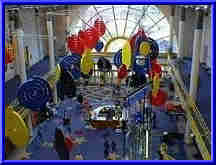
The five-story museum houses 100,000 artifacts in 10 major galleries that explore the physical and natural sciences, foreign cultures, history and the arts.
Many of the exhibits are participatory.
Visitors can ride a revitalized carousel, pet animals,explore a limestone cave, excavate at an archeological dig, experiment with computers, and much more.
In June 1996, the museum opened the new $2.5 million ScienceWorks gallery.
Children who visit the 12,000-square-foot gallery can dig for fossils; climb a 22-foot limestone rock wall; crawl through an earthen tunnel to see what happens underground;
crawl through an earthen tunnel to see what happens underground;
and move bricks and sandbags around on a two-story construction site, using a pedal-operated dump truck, wheelbarrows, dollies and wagons.
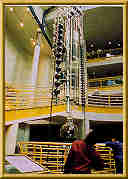 The IWERKS CineDome, a $10 million large-format movie theater, is adjacent to The Children's Museum, and opened in 1996.
The IWERKS CineDome, a $10 million large-format movie theater, is adjacent to The Children's Museum, and opened in 1996.
The five-story theater seats 312 people and features films that will complement the museum's educational exhibits and programs.
The Children's Museum is ranked number one in the nation by Family Fun magazine.
This is a must see when coming for a visit to Indianapolis!

Plan on spending several days in the city to catch all
that it has to offer. Museums certainly are abundant in Indianapolis.

EITELJORG MUSEUM OF AMERICAN INDIAN & WESTERN ART
The Eiteljorg Museum of American Indians & Western Art located itself in White River State Park in 1989.
The Museum has an unusual adobe architectural style which complements the artistic treasures located within.
The building style and blend of earth tones eliciting images of the desert Southwest. 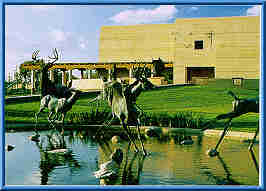
The museum's American West and Native American galleries highlight our American frontier experience.
This collection spans the early 19th century to the present, includes paintings and bronzes by artists such as Charles Russell, Georgia O'Keefe, Frederic Remington and members of the original Taos, New Mexico artists colony.
Temporary exhibits complement the museum's permanent collection and make each visit a new experience.
Considered one of the finest of its kind in the country, the collection originated with Indianapolis businessman Harrison Eiteljorg, who ventured west 45 years ago looking for coal.
 While there, he fell in love with the land, the people, and the art and returned with a fantastic cultural collection.
While there, he fell in love with the land, the people, and the art and returned with a fantastic cultural collection.
The Eiteljorg is the Midwest's source of educational entertainment about the West and Native America.
The annual Indian Market in June is the largest juried sale and show of Native American art in the region and showcases nationally known Native American performers.

Don't forget every Fall...The official statewide chili cookoff, amateur and professional cooks and corporate teams fire up their best and most delicious Texas-style chili,
homemade recipe or vegetarian version to vie for trophies in different categories, including the Chili Appreciation Society International (CASI) state championship.

The public samples and votes for their favorite chilis, and the samples do go fast, so you need to get there early!

MUSEUM OF ART
The Indianapolis Museum of Art with collections of Medieval, Renaissance, and 19th-century arts.
The Museum of Art, a fully integrated art museum, with a 152-acre park which includes gardens,five pavilions, a lecture hall, concert terrace, and shops.
The seventh largest and one of the oldest art museums in the country, the Indianapolis Museum of Art completed a massive $36.5 million renovation and expansion in 1990.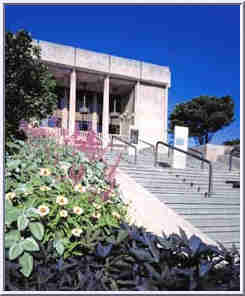
The expansion nearly doubled its exhibition space and added a new wing, the Mary Fendrich Hulman Pavilion, to house the Eiteljorg Collection of African Art.
Collections include the largest grouping of J.M.W. Turner watercolors and drawings outside of Great Britain, the W.J. Holliday Collection of Neo-Impressionist art,
the Clowes Fund Collection of Old Master paintings, the famous Love sculpture by Robert Indiana, and Eli Lilly Collection of Chinese Art, one of the most comprehensive collections of Oriental art in the nation.
The museum also includes the Eli Lilly Botanical Garden, restaurants, nature trails, and the Indianapolis Civic Theatre.

MORRIS-BUTLER HOUSE-MUSEUM
The Victorian Morris-Butler House Museum, demonstrates the life and customs of families 100 years ago.
The museum houses a nationally recognized collection of rare, high style Victorian decorative arts, and is a museum property of Historic Landmarks Foundation of Indiana. Listed, National Register of Historic Places.
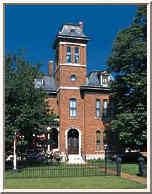 The restored Morris-Butler House has been called the best-kept secret in Indianapolis.
The restored Morris-Butler House has been called the best-kept secret in Indianapolis.
The 1865 Victorian landmark offers fascinating tours focused on architecture, decorative arts and family life in the mid-Victorian era.
Experience beauty and history as you tour all three floors of this restored museum home.
From the dramatic formal parlor to the private living quarters for family and staff, you'll learn how an upper-middle-class family (and their servants) lived in the second half of the nineteenth century.
Rare furnishings, including an ingenious Wooton desk, fill rooms adorned with stenciled ceilings and elaborate wallpaper and plasterwork.
In addition to its large permanent display of nineteenth-century art,
the Morris-Butler House collection contains sculptures, paintings and lithographs from all over the world.

PRESIDENT BENJAMIN HARRISON'S HOME-MUSEUMPresident Benjamin Harrison's Home Museum is the former residence of the 23rd U.S. president.
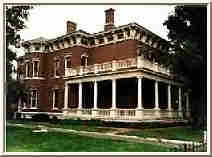 It is now a museum dedicated to his life. It is noted for its Victorian furnishings,
It is now a museum dedicated to his life. It is noted for its Victorian furnishings,
this three-story Italianate mansion features many original Harrison pieces.
Benjamin Harrison was the 23rd President of the United States from 1889 to 1893.
He was President 100 years after George Washington, which made him the Centennial President.
The Harrison Home houses some 3,700 artifacts and 2,440 books.
About 75% of the artifacts in the home actually belonged to the Harrison's.
In the home the visitors see ten of the rooms with period furnishings and Harrison items.
The third floor, originally a ball room, houses exhibits.
A new exhibit opens every six months with Harrison Home artifacts and borrowed artifacts. Textiles, dresses, and other artifacts are displayed through out the house.

JAMES WHITCOMB RILEY HOME
This 1872 home, was where Hoosier poet James Whitcomb Riley, spent the last 23 years of his life.

The home is a Victorian style house made out of brick and trimmed with stone.
The original furnishings are still in the house that was built in 1872.
Lockerbie Square where the Riley home is located, is a restored 19th-century downtown residential area.
The oldest Indianapolis neighborhood to be included in the National Register of Historic Places as a historic district, Lockerbie is characterized by old-fashioned street lights, a cobblestone street
and many restored simple, yet elegant houses and condominiums, and apartment buildings in renovated warehouses.
It is one of the finest Victorian preservations in the United States.
 INDIANAPOLIS ZOO
INDIANAPOLIS ZOOWhatever you do, save time during your visit to see the Indianapolis Zoo,
Opened in 1988, the $64 million Indianapolis Zoo is one of the few new zoos to be built from the ground up and is the nation's only accredited combined zoo, aquarium, and botanical garden.
It occupies 64 acres in White River State Park.
 It's facilities include the world's second-largest, fully-enclosed, environmentally controlled whale and dolphin pavilion and the state's largest aquarium.
It's facilities include the world's second-largest, fully-enclosed, environmentally controlled whale and dolphin pavilion and the state's largest aquarium.
The "cageless" zoo features more than 3,000 animals in simulated natural habitats and 1,700 species of plants.
The zoo's Encounters Exploration Center uses hands-on exhibits and interactive videos to demonstrate the interconnectedness of life and how plants and animals relate to humans.
 Visitors can hold a giant cockroach, watch the work of leaf-cutting ants, or scan the World Wide Web for facts about favorite animals.
Visitors can hold a giant cockroach, watch the work of leaf-cutting ants, or scan the World Wide Web for facts about favorite animals.
The Living Deserts of the World is a conservatory covered by an 80-foot diameter transparent dome.
A variety of plant and animal life, including free-flying birds and free-roaming lizards, reside under its geodesic roof.
This past year we have also seen the arrival of a new baby elephant and a new baby dolphin!
and a new baby dolphin!

SOLDIERS' AND SAILORS' MONUMENT Located at the center of Indianapolis on Monument Circle, this 284-foot limestone monument was dedicated in 1902
Located at the center of Indianapolis on Monument Circle, this 284-foot limestone monument was dedicated in 1902
and stands as a tribute to the valor of Indiana's soldiers and sailors who served in the Civil and Spanish American Wars.
An observation tower, accessible by an elevator or 32 flights of stairs, provides a panoramic view of the skyline.
A new museum honoring the sacrifices made by Indiana citizens who lived, fought and died during the Civil War is now open.
The Col. Eli Lilly Civil War Museum is located in the lower level of the Soldiers and Sailors Monument.
Visitors can experience the Civil War from the battlefield to the homefront.
 Artifacts, letters and personal diaries written by Hoosiers during the war are the foundation for the exhibits.
Artifacts, letters and personal diaries written by Hoosiers during the war are the foundation for the exhibits.
The museum preserves the rich history of the Soldiers and Sailors Monument.
For generations, the Indiana Soldiers' and Sailors' Monument has stood majestically as a tribute to the past and an inspiration for the future.
More than 24,000 Hoosiers gave their lives to preserve the Union.
Although Indiana was geographically a border state, 74.3 percent of all eligible men served in the Union army, a percentage higher than every state except Delaware.
 In 1862, long before the Civil War ended, a letter to the editor in the Indianapolis Daily Journal suggested that the state should "erect a monument... to the memory of all the dead of Indiana who have fallen in defense of the Union."
In 1862, long before the Civil War ended, a letter to the editor in the Indianapolis Daily Journal suggested that the state should "erect a monument... to the memory of all the dead of Indiana who have fallen in defense of the Union."
Forty years passed between that suggestion and the dedication of the Monument in 1902. 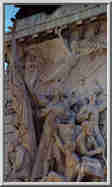
Recognized as one of the world's outstanding monuments, the structure has become the symbol of both Indiana and the city of
Indianapolis.
It has been estimated that building a similar structure today would cost more than five hundred million dollars.
The monument is a unique example of the sculptural art of its time, featuring images representative of both history and mythology.
The Monument's museum contains artifacts from the Civil War and the Spanish American War.
A few of the items on display are cannons, uniforms, and a piece of the Maine.
The Monument and surrounding circle also provides a venue for a variety of civic and cultural events.
Every November 24 on Monument Circle.
In keeping with tradition, Indianapolis ushers in the holiday season as they flip on the lights.
Visitors will enjoy the "tree," with 4,638 lights and 52 garland strands used to create the 242 foot display.
The magic continues with toy soldiers and peppermint sticks encircling the Monument.
Snowflakes and stars will delight on-lookers as they dance across the skyline,
and icicle flags on light poles will add shimmer to the walkways as a glow is cast from 63 lighted trees surrounding the Circle.

U.S.S. INDIANAPOLIS
This National Memorial is the climax of a 50 year dream by the crew members who survived the sinking of the cruiser USS Indianapolis in 1945.
members who survived the sinking of the cruiser USS Indianapolis in 1945.
They worked continually to erect a fitting memorial to their missing shipmates.
The Memorial is located at the North end of the Canal Walk in downtown Indianapolis.
 The Memorial is an outdoorsite and is available to the public 24 hours a day, seven days a week.
The Memorial is an outdoorsite and is available to the public 24 hours a day, seven days a week.
Engraved on the South face of the monument are the names of the ship's company and one passenger who made up her final crew.

CONGRESSIONAL MEDAL OF HONOR MEMORIALThe only memorial designed to honor recipients of the nationís highest award for military valor is open in downtown Indianapolis.
The memorial honors 3,410 Medal of Honor recipients, which is awarded by Congress for military valor.
The one-acre memorial is located on the north side of the downtown Central Canal in White River State Park.
The memorial represents 15 different conflicts, ranging from the Civil War through Somalia.
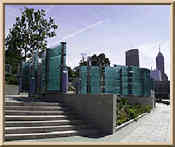
There you'll find 27 walls of curved glass, representing every conflict since the Civil War when the Medal of Honor was established by Congress.
Rather than glorifying war, the Memorial is a celebration of courage, heroism and the human spirit.
Landscape architects and designers of the Memorial, Eric Fulford and Ann Reed, chose glass for the tribute because of its quality of being both fragil and strong.
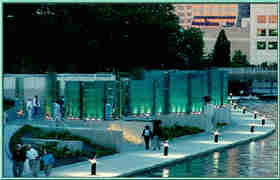 Each of the 27 glass sails have two parallel layers of 3/4-inch industrial glass, erected twelve inches apart.
Each of the 27 glass sails have two parallel layers of 3/4-inch industrial glass, erected twelve inches apart.
The names of the recipients are etched on the front side of the front layers, where they can be touched by visitors.
A ring of 34 stars on the back, untouchable and protected reflects how a person can be touched, but the Medal belongs solely to the person who earned it.
Every night at dusk, all the walls' lights gradually go to full illumination, then drop to about 30 percent illumination after 15 minutes.
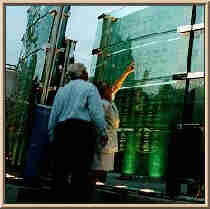 One wall at a time is lighted, and a recorded voice tells the story of a recipient who was part of the wall's conflict.
One wall at a time is lighted, and a recorded voice tells the story of a recipient who was part of the wall's conflict.
A computerized sound system allows the stories to change each day.
A touch-screen monitor provides additional information about the recipients.
Steps, benches and a grassy area offer seating for visitors to rest and absorb the Memorial's meaning and beauty.

INDIANA WAR MEMORIAL
Dominating the five-block picturesque setting of War Memorial Plaza in downtown Indianapolis is the Indiana World War Memorial.
The mausoleum-style limestone and marble memorial pays homage to Hoosiers killed during World Wars I and II, the Korean War and the Vietnam War.
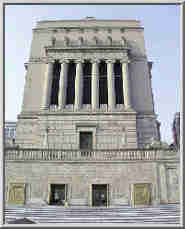 The Shrine Room, with 24 stained-glass windows, is a magnificent architectural setting for the 17-by-30 foot American flag that is suspended from the center of the room.
The Shrine Room, with 24 stained-glass windows, is a magnificent architectural setting for the 17-by-30 foot American flag that is suspended from the center of the room.
A military museum in the basement allows visitors to follow the history of Indiana soldiers from the Battle of Tippecanoe through the most recent wars.
North of the memorial is the American Legion Mall, a park-like setting that includes the American Legion State and National Headquarters, as well as the Vietnam, Korean and World War II memorials.
The mall is a popular site for festivals and events.
Also a part of the grounds are the Veteransí Memorial Plaza, where the flags of all 50 states fly,
and University Park, which features the DePew fountain and statues of Abraham Lincoln, Benjamin Harrison and Schuyler Colfax.



"Hey!!! No stopping now, time to see the rest of Indianapolis!!"

PLEASE CLICK ON THE LICENSE PLATE BELOW TO BRING YOU TO PAGE THREE OF THE TOUR!!
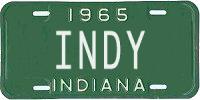
 "Back Home In Indiana"
"Back Home In Indiana"





 The Natatorium is located on the IUPUI campus and has been proclaimed the fastest pool in the world. Seventy-nine American and ten world records have been broken here.
The Natatorium is located on the IUPUI campus and has been proclaimed the fastest pool in the world. Seventy-nine American and ten world records have been broken here. and we also have the Taylor Velodrome for cyclists.
and we also have the Taylor Velodrome for cyclists. 
 The Children's Museum of Indianapolis attracts nearly a million adults and children a year.
The Children's Museum of Indianapolis attracts nearly a million adults and children a year.

 crawl through an earthen tunnel to see what happens underground;
crawl through an earthen tunnel to see what happens underground; The IWERKS CineDome, a $10 million large-format movie theater, is adjacent to The Children's Museum, and opened in 1996.
The IWERKS CineDome, a $10 million large-format movie theater, is adjacent to The Children's Museum, and opened in 1996.


 While there, he fell in love with the land, the people, and the art and returned with a fantastic cultural collection.
While there, he fell in love with the land, the people, and the art and returned with a fantastic cultural collection.




 The restored Morris-Butler House has been called the best-kept secret in Indianapolis.
The restored Morris-Butler House has been called the best-kept secret in Indianapolis. It is now a museum dedicated to his life. It is noted for its Victorian furnishings,
It is now a museum dedicated to his life. It is noted for its Victorian furnishings,

 It's facilities include the world's second-largest, fully-enclosed, environmentally controlled whale and dolphin pavilion and the state's largest aquarium.
It's facilities include the world's second-largest, fully-enclosed, environmentally controlled whale and dolphin pavilion and the state's largest aquarium. Visitors can hold a giant cockroach, watch the work of leaf-cutting ants, or scan the World Wide Web for facts about favorite animals.
Visitors can hold a giant cockroach, watch the work of leaf-cutting ants, or scan the World Wide Web for facts about favorite animals. and a new baby dolphin!
and a new baby dolphin!
 Located at the center of Indianapolis on Monument Circle, this 284-foot limestone monument was dedicated in 1902
Located at the center of Indianapolis on Monument Circle, this 284-foot limestone monument was dedicated in 1902 Artifacts, letters and personal diaries written by Hoosiers during the war are the foundation for the exhibits.
Artifacts, letters and personal diaries written by Hoosiers during the war are the foundation for the exhibits.
 In 1862, long before the Civil War ended, a letter to the editor in the Indianapolis Daily Journal suggested that the state should "erect a monument... to the memory of all the dead of Indiana who have fallen in defense of the Union."
In 1862, long before the Civil War ended, a letter to the editor in the Indianapolis Daily Journal suggested that the state should "erect a monument... to the memory of all the dead of Indiana who have fallen in defense of the Union."

 members who survived the sinking of the cruiser USS Indianapolis in 1945.
members who survived the sinking of the cruiser USS Indianapolis in 1945. The Memorial is an outdoorsite and is available to the public 24 hours a day, seven days a week.
The Memorial is an outdoorsite and is available to the public 24 hours a day, seven days a week.
 Each of the 27 glass sails have two parallel layers of 3/4-inch industrial glass, erected twelve inches apart.
Each of the 27 glass sails have two parallel layers of 3/4-inch industrial glass, erected twelve inches apart. One wall at a time is lighted, and a recorded voice tells the story of a recipient who was part of the wall's conflict.
One wall at a time is lighted, and a recorded voice tells the story of a recipient who was part of the wall's conflict. The Shrine Room, with 24 stained-glass windows, is a magnificent architectural setting for the 17-by-30 foot American flag that is suspended from the center of the room.
The Shrine Room, with 24 stained-glass windows, is a magnificent architectural setting for the 17-by-30 foot American flag that is suspended from the center of the room.


 "Back Home In Indiana"
"Back Home In Indiana"